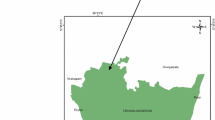Abstract
Scarcity of groundwater necessitates the present study to evaluate groundwater potential and quality for designing suitable water management plans in the Bhatsa and Kalu river basins in the Thane district in the western Deccan volcanic province of India. A Geographical Information System platform is used to integrate and spatially analyse multiparametric data comprised of satellite, topographical, geological and hydrogeological information to generate several thematic maps, including groundwater potential zonation map. This study reveals that 70% of the area has medium to low groundwater potential, while only 10% has high potential. The static and dynamic groundwater potentials are estimated to be 10.7 and 4.8% of the annual rainfall. The groundwater quality in terms of hardness, total dissolved solids, salinity and chloride is suitable for domestic and irrigational purposes. A database is developed for sustainable water management program for the region and areas where suitable water conservation techniques need to be adopted are identified.




Similar content being viewed by others
References
APHA (1998) Standard methods for the examination of water and wastewater, American Public Health Association
Caroll D (1962) Rain water as a chemical agent of geological processes—a review. USGS water supply 1533:18–20
Deolankar SB (1980) The Deccan basalts of Maharashtra, India—their potential as aquifers. Ground Water 18:434–437
Edet AE, Okereke CS, Teme SC, Esu EO (1998) Application of remote-sensing data to groundwater exploration: a case study of the Cross River State, southeastern Nigeria. Hydrogeol J 6(3):394–404
Indian Standards Institution (1983) Indian standard specification for drinking water. IS 10500
Jaiswal RK, Mukherjee S, Krishnamurthy J, Saxena R (2003) Role of remote sensing and GIS techniques for generation of groundwater prospect zones towards rural development—an approach. Int J Remote Sens 24(5):993–1008
Jensen JR (1996) Introductory digital image processing: a remote sensing perspective. Prentice-Hall, Englewood Cliffs, pp 379
Karanth KR (1987) Groundwater assessment, development and management. Tata McGraw Hill, New Delhi, pp 720
Krishnamurthy J, Venkatesa Kumar N, Jayaraman V, Manuvel M (1996) An approach to demarcate groundwater potential zones through remote sensing and a geographical information system. Int J Remote Sens 17(10):1867–1884
Meijerink AMJ (1996) Remote sensing applications to hydrology: groundwater. Hydro Sci J 41(4):549–561
Ministry of Irrigation (1984) Groundwater Estimation Methodology. Govt of India, p 37
Nour S 1996 Groundwater potential for irrigation in the East Oweinat area, Western Desert, Egypt. Environ Geol 27(3):143–154
Raju KCB (1998) Importance of recharging depleted aquifers: state of the art of artificial recharge in India. J Geol Soc India 51:429–454
Rao YS, Jugran DK (2003) Delineation of groundwater potential zones and zones of groundwater quality suitable for domestic purposes using remote sensing and GIS. Hydro Sci J 48(5):821–833
Richards LA (1954) Diagnosis and improvement of saline and alkali soils, Agric. Handbook 60, US Department of Agriculture, Washington DC, p 160
Saraf AK, Choudhury PR (1998) Integrated remote sensing and GIS for groundwater exploration and identification of artificial recharge sites. Int J Remote Sens 19(10):1825–1841
Sawyer GN, McCartly DL (1967) Chemistry of sanitary engineers, 2nd edn. McGraw Hill, New York, p 518
Smith SE, El-Shamy I, Abd-El Monsef H (1997) Locating regions of high probability for groundwater in the Wadi El-Arish Basin, Sinai, Egypt. J Afr Earth Sci 25(2):253–262
Walsh SJ, Butler DR, Malanson GP (1998) An overview of scale, pattern, process relationships in geomorphology: a remote sensing and GIS perspective. Geomorphology 21(3–4):183–205
World Health Organization (1971) International standards for drinking water, Geneva
Acknowledgements
The authors are thankful to Prof. S.D. Shah for his advice, and Mr. Suprio Mitra and Mr. Jibanendu Acharya for chemical analysis of water samples. The grant from IRCC, IIT Bombay towards charges for publishing colour figures is gratefully acknowledged. The first author thanks the Director, Indian Institute of Technology Bombay for providing the Ph.D. scholarship to carry out this study.
Author information
Authors and Affiliations
Corresponding author
Rights and permissions
About this article
Cite this article
Shankar, M.R., Mohan, G. Assessment of the groundwater potential and quality in Bhatsa and Kalu river basins of Thane district, western Deccan Volcanic Province of India. Environ Geol 49, 990–998 (2006). https://doi.org/10.1007/s00254-005-0137-5
Received:
Accepted:
Published:
Issue Date:
DOI: https://doi.org/10.1007/s00254-005-0137-5




